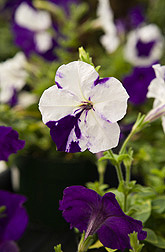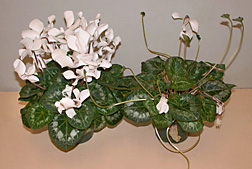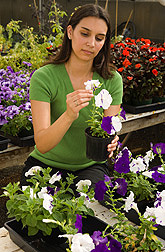New Ideas for Longer Lasting Blooms
Blossom in California Laboratory
Maybe you’ve experienced the frustration of picking out the perfect bouquet or potted plant, only to have its attractive blossoms wither and droop just a few days later.
Help may be on the way.
Floriculture research from the laboratory and greenhouse of plant physiologist Cai-Zhong Jiang might help growers, retailers, and you boost the vase life of your favorite cut flowers and extend the shelf life of your prized potted plants.
Jiang is with ARS’s Crops Pathology and Genetics Research Unit at Davis, California, about 75 miles northeast of San Francisco.
With co-investigators from the University of California-Davis (UCD) and the Universities of Florida and Reading (United Kingdom), Jiang is experimenting with a number of practical tactics to forestall plants’ natural aging, called “senescence.” In longer term research, he’s digging into the underlying causes, or gene-controlled mechanisms, of aging. Such probing may eventually lead to discoveries of how to modify flowers’ aging-linked genes or the proteins that are products of those genes.
In one series of studies, Jiang, UCD colleague Michael S. Reid, and co-researchers have shown that spraying low concentrations of a commercially available compound known as thidiazuron (TDZ), short for N-phenyl-N'-(1,2,3-thiadiazol-5-yl)urea, has what Jiang describes as “significant, sometimes spectacular, effects” in extending the life of potted plants’ leaves and flowers. For example, in tests with greenhouse-grown cyclamen plants, TDZ-treated plants “had a longer life than unsprayed plants—more than a month longer,” he says.
|
|
Importantly, TDZ sprays, added to water and applied in concentrations of 5 to 10 parts per million, didn’t play havoc with the shape of the plants. That’s important, because disfigurement is a common and unwanted side effect of some other compounds commonly used commercially to offset aging of blooming plants, Jiang points out.
TDZ, a synthetic version of a naturally occurring plant hormone known as a “cytokinin,” is not new. Perhaps surprisingly, it’s used in higher concentrations to cause cotton plants to drop their leaves so that mechanical harvesters can more easily pluck the plants’ fluffy white bolls. But preliminary studies with cut flowers, reported by Reid and co-researchers in 2000, showed that smaller doses of the defoliant extended the life of alstroemeria leaves. The study was the first to demonstrate the value of TDZ for a commercial floricultural species. The cyclamen experiments conducted by Jiang and his collaborators are the first to show the leaf-saving and blossom-boosting effects of TDZ with potted floricultural plants.
Though commercial, after-harvest use of the compound—on cut flowers and potted plants—seems promising, the researchers’ deeper interest lies in determining precisely how TDZ affects genes and proteins inside the plants. “We want to understand exactly how TDZ works,” says Jiang. Ideally, the research would yield innovative strategies to make TDZ even more effective with today’s most popular ornamental species. What’s more, the studies may determine how to sidestep the nonresponsiveness of some popular potted plants to TDZ. One example: Jiang and teammates want to determine why TDZ helps maintain freshness of some kinds of miniature potted roses, but not others.
|
|
Identifying Genes That Cause Aging
Meanwhile, another approach is already teasing out some clues about genes of interest. Known as “virus-induced gene silencing,” or VIGS, this technique allows scientists to determine the function of genes in senescing plants. The scientists insert a gene, or genes, of interest into the naturally occurring tobacco rattle virus. Next, in laboratory experiments, the researchers expose plants to the virus. Doing that triggers the plants’ natural defense mechanism, which includes attempting to quash, or silence, the invader virus. When that happens, the gene or genes that scientists inserted into the virus are also silenced. By comparing the VIGS plants with those not exposed to the retooled virus, scientists may be able to determine the silenced gene’s function.
In proof-of-concept experiments, Jiang, Reid, and co-investigators used petunia as their model plant and showed that inserting a piece of a color-imparting gene into the virus resulted in white splotches or sectors on a normally purple-flowering petunia. “We tricked the plant’s defense system into squelching the gene’s normal job of creating color,” explains Jiang. A second gene fragment that the team also inserted into the virus was similarly silenced in the oddly white sectors. That silenced gene would normally have been involved in producing ethylene, an aging compound. But white sectors on the virus-infected plants produced less ethylene than plants not exposed to the virus, the researchers found.
“The basic idea here is that we can use the virus as a tool to quickly turn off genes, to see which ones control senescence,” says Jiang. Though used elsewhere to study senescence in tomato and barley, the experiments by Reid, Jiang, and colleagues are the first to use VIGS to explore senescence mechanisms in commercially grown cut flowers and potted plants.
In studies reported in the 2009 book Petunia: Evolutionary, Developmental, and Physiological Genetics, the scientists indicate that the technique can be used to study as many as five independent genes in a single experiment. That’s an invaluable timesaver, especially since two of their targets, known as “NAC” and “MADS box transcription factor” genes, act as master switches, each controlling many other genes in the so-called senescence network.
In all, the investigations may result in new, economical, and environmentally friendly ways to extend the life of cut flowers and potted plants. It’s research that could prolong the beauty and vitality of cherished plants and our enjoyment of them, as well.—By Marcia Wood, Agricultural Research Service Information Staff.
This research is part of Crop Production, an ARS national program (#305) described at www.nps.ars.usda.gov.
Cai-Zhong Jiang is in the USDA-ARS Crops Pathology and Genetics Research Unit, 1 Shields Ave., Davis, CA 95616; (530) 752-7060.
"New Ideas for Longer Lasting Blooms Blossom in California Laboratory" was published in the April 2010 issue of Agricultural Research magazine.









